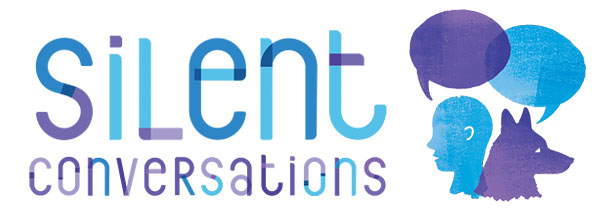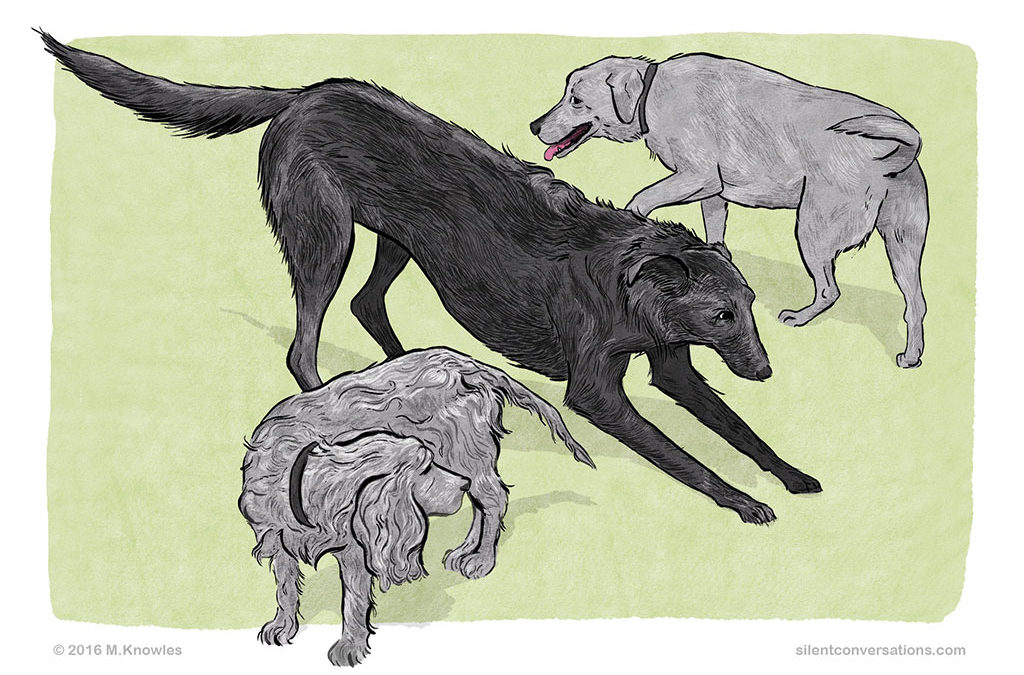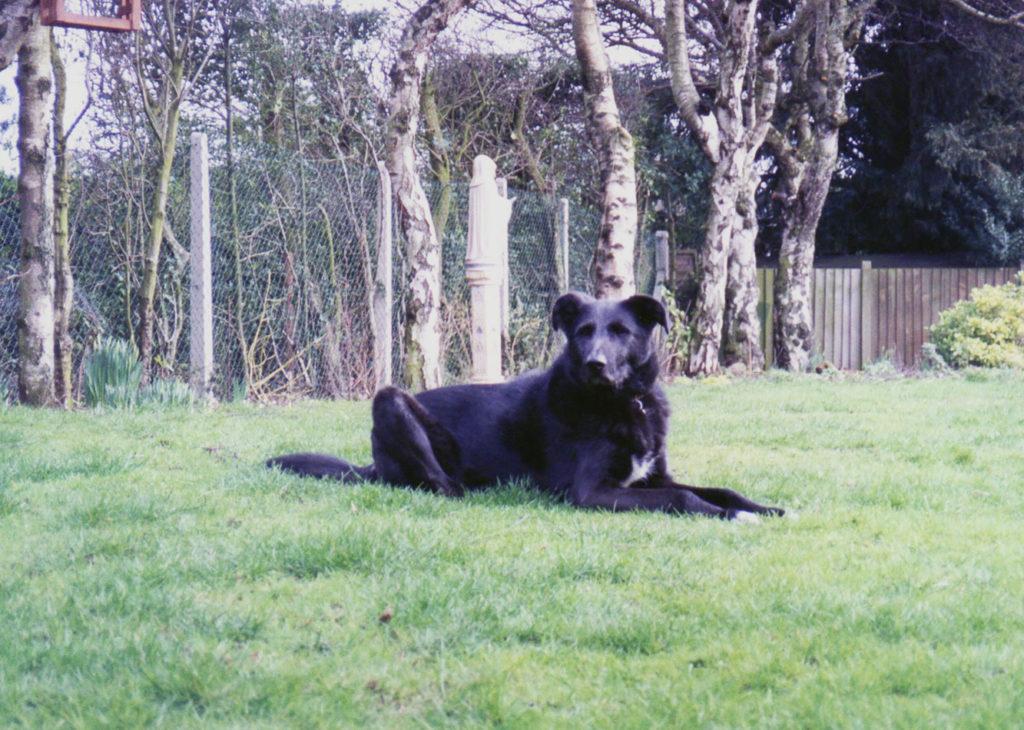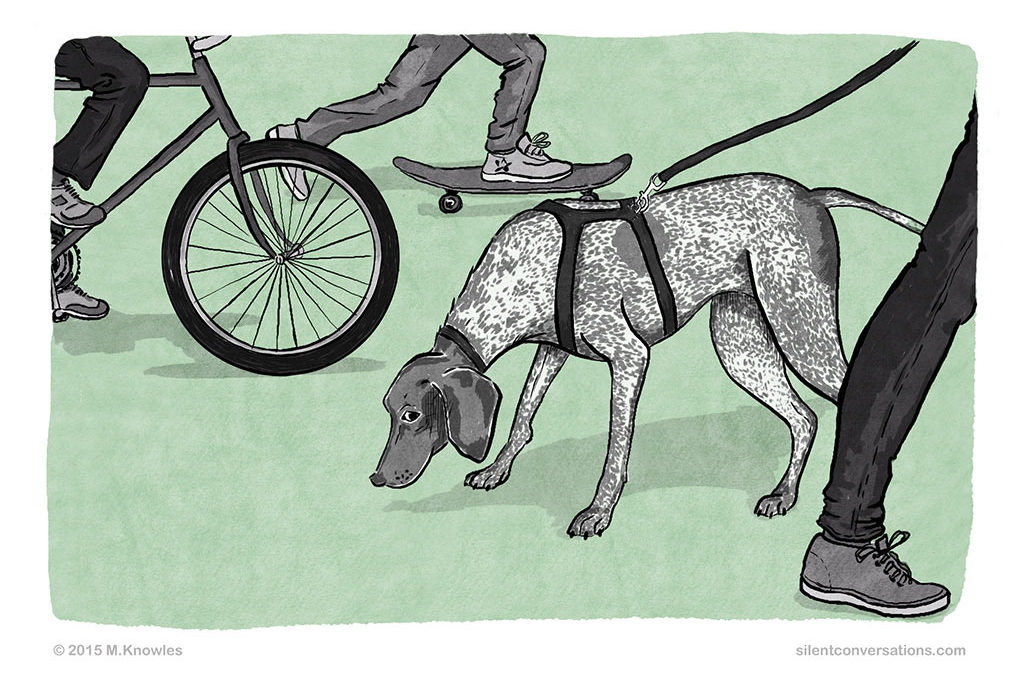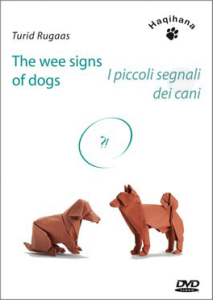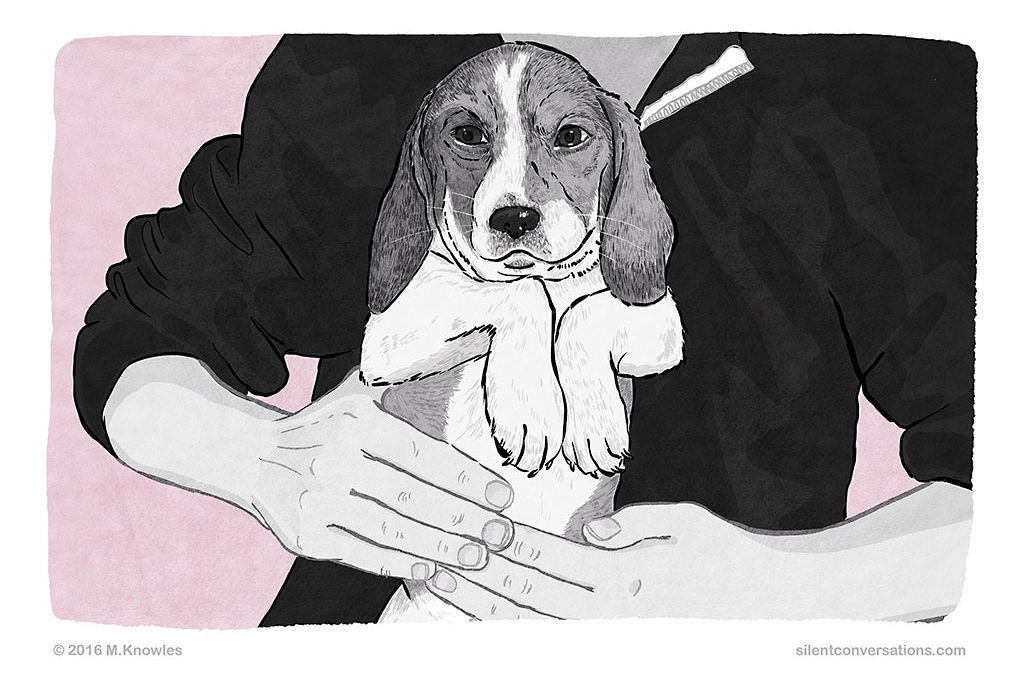
How do you greet a dog politely?
How do you greet a dog politely?
I was visiting a friend’s house for a small social gathering. One of the people visiting brought her beagle puppy to the occasion. Everyone adored the puppy and solicited her attention, immediately wanting to touch or hold her when greeting her. What was telling was that for most of the time that people chatted away at the gathering, the puppy chose to move away from the traffic of people to go sniffing around the apartment in the quieter corners. So, when she had free will to choose where she could go, she chose to stay away. Not much attention is paid to such subtle choices, and you could say there is not much to observe with respect to body language, but the behaviour of the puppy was telling. The fact that she made the choice not to solicit touch or attention and wanted to create more space between herself and the crowd of people speaks quite loudly on its own.
How dogs use and create space when they are interacting with an environment or individual can speak volumes. The amount of space and how it is used are key points. It is also interesting to observe how much confidence and skill individual dogs show in choosing to use the environment by increasing distance, decreasing distance or being able to make the choice to walk away – each dog has his or her own skill set, depending on experience and personality.
It is in our human nature as a species to want to interact with other animals through touch, which we seem to take for granted as an acceptable way for other animals to interact. We might not make the same choices regarding touch when interacting with unknown humans. Patricia McConnell shares some wonderful footage of the interactions of different animal species on her DVD “Lost in Translation”. Starting from 7:09 on the first DVD, there is video showing bonobo chimps interacting, followed by footage of humans interacting with their dogs in a dog class. Patricia points out the similarities in behaviour between the humans and the bonobo chimps with relation to interactions involving hands and touch. In the footage you can see humans repeatedly touching their dogs in the dog class and, similarly, bonobo chimps constantly patting and touching each other during their interactions.The similarities between humans and bonobos using their hands in communication is striking and shows the shared behaviours between us and our primate relations.If you were to watch footage of dogs or wolves interacting, it would not be as common for them to place a paw on each other. In dog interactions, such instances could be seen as rude or bullying. It is worth taking note of the differences in behaviour between the human and canine species and the expectations we may have from a human perspective without considering the canine perspective.
On occasion, while I have been walking my dog, adults, generally accompanied by their children, have approached me and asked permission to pet my dog. Culturally we don’t give much thought as to whether such a request by complete strangers walking up to us is appropriate. There are a few questions to consider in such situations: What is considered a polite greeting from a dog’s perspective? Has any thought been given to the free will for the animal to choose whether they wish to interact with a complete stranger? Even with social interactions within our own species, touch may be appropriate or inappropriate, depending on whom we are interacting with, how comfortable we feel and the social situation we are in. Imagine a stranger walking up to you and running their hands through your hair or hugging you? The thought feels a bit creepy doesn’t it?
How would a dog greet another dog politely?
In dog body language, careful negotiation of space and polite body language is key. Direct eye contact and a direct frontal approach could be seen as confrontational. Communication will normally start at a distance away. One of the dogs may stop and sniff the ground as a calming signal and wait for appropriate body language signals. The dogs may then slowly approach each other in a curve or curving of their bodies rather than a frontal approach. They would take their time approaching, sharing appropriate body language and calming signals. After approaching, they might slowly curve round to sniff behind and then slowly move away from each other. If the sniffs are too invasive, the one dog may walk away, sniff the ground or give signals that he is not comfortable with too much invasion of space. He may even pee on the ground and walk away to give the other dog a chance to have a better sniff without too much contact. After a short introductory sniff of each other, they may go on their separate ways or stay nearby to share some sniffs of the environment and amble around together.
Dogs usually avoid eye contact when being polite, but they do squint their eyes (called shortening of the eye) or blink when giving selected careful eye contact; both of these could be seen as calming signals. These signals could be used to calm the other party down, as a friendly gesture or to show the other party that they are no threat (depending on the circumstances of the interaction).
So how can a human greet a dog in a polite manner?
-
Firstly, do not approach the dog; let him approach you. It is always best to give the dog choice and let him decide whether he would like to approach or not. Allow the dog to have enough space to move away; do not restrict his movement in any way by holding, touching or blocking access to escape by the position you choose to stand in.
-
A frontal approach (facing the dog) could be seen as rude or threatening in dog body language; turning your body side-on so your one shoulder is facing the dog is much more inviting. Stand still and wait for him to make the choice whether he would like to approach you or not.
-
In dog body language, direct eye contact can be seen as rude and is normally used to warn or threaten. Try to avoid direct eye contact by turning your head away ever so slightly and using your peripheral vision instead. Or if you do give eye contact, do so for short periods, with ever so slightly squinted, softened eyes (slight squinting and softening your eyes will most probably encourage you to smile) or blink slowly when doing so.
-
Once the dog has come up and given you a sniff, let him walk away and leave, especially if it is a dog you do not know.
-
If the dog guardian is there, it is best to ask for permission if you would like to pet the dog, and you should ask what type of contact the dog enjoys. Some dogs do not want to be touched; a hands-off greeting is perfectly appropriate and all that is needed. The dog will be perfectly happy with a quick sniff and walk away. I know for us humans it may feel like we have been snubbed, and somehow we don’t feel complete without touching. Our egos get bruised easily if there is no contact, and we feel the dog might not like us. There is actually a greater chance of the dog becoming friends with you and liking you if your greeting is a hands-off one. The dog will appreciate your polite gesture of being respectful of his space.
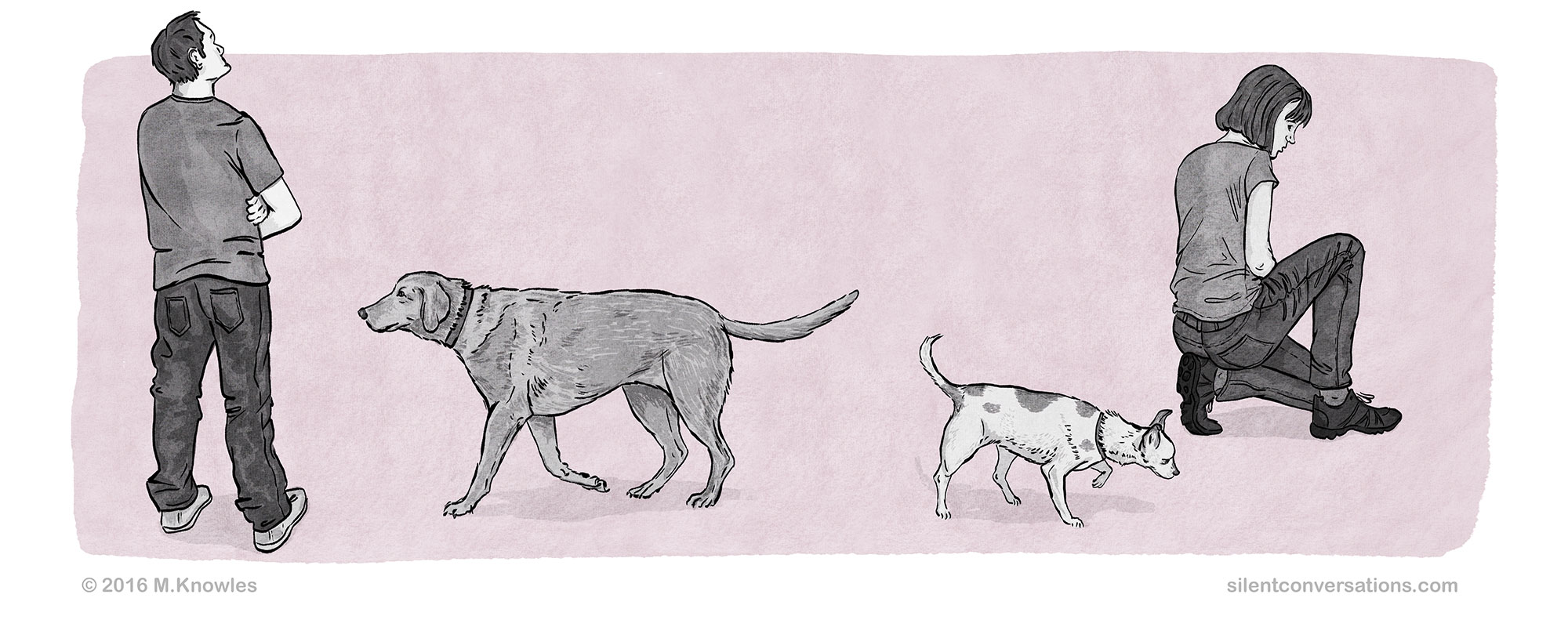
My dog is generally friendly with people and is good-natured, but he does not feel comfortable with all people. It takes time for him to warm up to strangers. His reactions may vary, depending on how comfortable he feels with someone and the situation he is placed in. He may bark at people he is not comfortable with or he may shy away, not masking his fear. It is easier for people to notice fearful reactions when dogs shy away, but they often don’t realise that a dog that is barking could actually be fearful too. It may be difficult inviting new guests who are not aware of dog body language into the house, and, depending on the guests’ comfort level, it can be overwhelming being given a list of dog body language to follow when interacting with a dog. I generally choose to manage the situation by either removing my dog from the environment or, depending on the person, asking them to just ignore my dog – this seems to be the simplest instruction if trying not to overwhelm someone. I have the great fortune of having a few friends who are well versed in dog body language, which makes an introduction with my dog so much easier. It is a real joy when I can step back. I had a dog savvy friend come over, and she showed some wonderful body language to introduce herself to my dog. He is a smaller dog, so she crouched down* at a distance, with her body turned away (about three-quarters side-on to my dog). This allowed my dog to make the choice whether to approach. Due to her posture and position, he felt comfortable enough to approach and have a good sniff; he then had the choice to walk away and did not have to endure being touched. This interaction was really positive for him; he walked away with a relaxed body and gentle tail wag. Due to his space being respected, I have noticed his relationship with this person has grown quickly, as it started on such a positive note. He now seeks out this person when seeing them, approaching with gentle tail wags and a soft body. As this relationship grows and he learns to trust this person, he will allow himself to be touched and will accept scratches with time.
* Just a safety note on crouching down: It does make smaller dogs feel more comfortable if you do not loom over them, so crouching is an option when you interact with small dogs. However, I would not crouch down with a dog you do not know, as this puts you in a vulnerable position. If you misjudge the body language and you make a wrong move, your face is nearer to the dog when you crouch down and is not in the safest position should you get bitten. I would especially avoid crouching down for larger dogs. Turning side-on whilst standing is sufficient for larger dogs. Please take note that if you do crouch down for a small dog, it is better doing so at a distance, as crouching down suddenly into the dog’s space could unsettle him.
A hands-off greeting between human and dog is perfectly polite and adequate from a dog’s perspective. Invading space can be seen as impolite behaviour and could start the relationship on a bad note.
Sometimes the dog will not show ‘calming signals’. What can you observe in situations like this?
Going back to the social gathering and the beagle puppy: At one stage a person was overwhelmed with the cuteness of the puppy and grabbed the puppy to hug it. The puppy landed up lying on its back and being held by the person. Normally you would look for calming signals like lip licks, head turns and yawns as signs of stress indicating how the dog is coping with an interaction. I was surprised there were no calming signals displayed. Did this mean the puppy was comfortable with the interaction and being held in this manner? No, the puppy was not comfortable at all! It is important to look at the body language as a whole – not just the signals.
There may be various reasons as to why signals may not be shown, depending on the individual. Here are some possible reasons to consider:
-
The individual may be too stressed; she may simply be shutting down.
-
The dog’s signals may not have been listened to in the past, so she does not find it beneficial strategy to use them.
-
Each individual has different skills and experiences when it comes to communicating; this may lead to different communication strategies.
-
The dog may not feel confident expressing herself directly.
I always feel more comfortable when I see signals and become a bit more wary when I don’t see them. It is easier to read when there is direct communication and deliberate signals are apparent. This is why it is vital to listen to and encourage communication.
What body language did I observe in the puppy to know she was not comfortable?
The puppy initially flinched away, her body was stiff and frozen as she was held, her mouth was closed (and you could see a bit more tension around the mouth/lip area), her eyes were large and there was a bit of whale eye (seeing the whites of the eye). When the person let go of her, she immediately chose to walk away, removing herself rather than staying close and did a small shake off (this is when the dog shakes herself ever so slightly as if she were shaking water off, even though she is not wet). The shake off may occur after a stressful event. She then continued to remove herself and walked away to another room.
How do you know whether your dog is enjoying being petted?
I prefer to avoid touching dogs that I do not know and have not yet established a foundation of trust with. In the case of your own dog, if you have built up a relationship with him, you can watch the responses he gives you through his body language. Some dogs are fine and will actually solicit touch; some are not that keen, while some ask for it occasionally on their terms. There are some that prefer petting only from people they know. I would recommend trying a body language observation session with your own dog and videoing the interaction so that you can look at it objectively.
Even when petting your own dog, it is still worth using polite body language: sit side-on with your one shoulder facing your dog. Once again, try not to give too much direct eye contact. When giving any eye contact, try squinting ever so slightly or blinking slowly. In general, dogs do not really feel comfortable with hands going over their heads, so try slowly moving your hand to the chest area or side of the shoulder. Give a gentle scratch and do so for the count of about 3 seconds, then take your hand away. Observe for body language signals such as lip licks, yawning, head turns, freezing, and try to notice if your dog moves his body away or ducks away. If you see any such body language, the dog may prefer your quiet company without touch. If he leans in or paws for more, then it is very clear he would like you to continue. Sometimes dogs may have a specific spot they prefer to have scratched; each is an individual. Often body language like freezing or walking away is overlooked, as to the uninformed it may look as if nothing is happening, but these subtle signals speak very loudly.
There is another scenario that may occur when you are observing whether your dog is enjoying petting. He may show mixed signals; for instance the dog moves in closer to you for scratches or does not move away but at a point starts showing lip licks. The dog may not necessarily dislike the whole experience, but he may feel conflicted at some stage during it. Sometimes things within the interaction change; the dog may have moved in and been fine with one-handed scratches, but when the person moved to scratching with both hands, the dog may have felt uncomfortable and trapped. Another reason could be that an obliging dog may not have as much confidence to remove himself from a situation; he may have initially enjoyed scratches, but then he started to regret his choice, as the situation might have gotten too much for him. When observing, it is worth giving breaks from scratching, just to monitor whether the dog still wants to be petted. By stopping the scratching, you are really asking, “Is this ok?” and accepting that the situation may keep changing, so it is important to keep watching, reassessing and readjusting according to what you observe.
I hope this changes expectations and helps to create awareness of how species differ with regard to greetings. What may be appropriate in human terms might not be so in dog terms. Open the conversation, ask for permission, listen and readjust when necessary. A hands-off greeting is perfectly polite in dog terms; being respectful of space will help build trust and will ultimately start your friendship on the right note.
I will leave you with an informative video of a ‘Consent test’ by Eileen from eileenanddogs.com
In the first half of the video you can observe some body language signals by Zani such as lip licks and head turns, showing she wishes not to be pet. Then observe the difference in body language in Summer from about 2:36 in the video. Summer softens her eyes displaying wonderful ‘shortening of the eye’ as part of her communication expressing comfort with petting.
Video Credit: Eileen Anderson from eileenanddogs.com
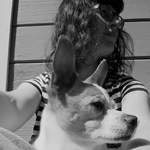
Martha Knowles
Author
My vision is to create a community of dog guardians who share their observations and interpretations of their dogs’ silent conversations. Hopefully, these experiences and stories will provide some insight into dog communication, which is often overlooked by the untrained eye because it is unfamiliar to humans. We are accustomed to communicating mainly with sound, so we are not attuned to the silent subtle gestures and body language used by dogs to communicate. If you take the time to observe, you will start to see these 'silent conversations' going on around you. My dream is for dog communication to become common knowledge with all dog guardians and as many people as possible. Surprisingly, there are still some professionals working in various dog-related careers who are uneducated about dog body language. Greater awareness of how dogs communicate will help to provide better understanding and improve the mutual relationship between dogs and humans. This will promote safer interactions between our two species and hopefully remove some of the expectations placed on dogs within human society. I would like dog guardians to feel empowered with their knowledge of dog communication so that they can be their dogs’ advocates and stand up for themselves and their dogs when it really matters.
